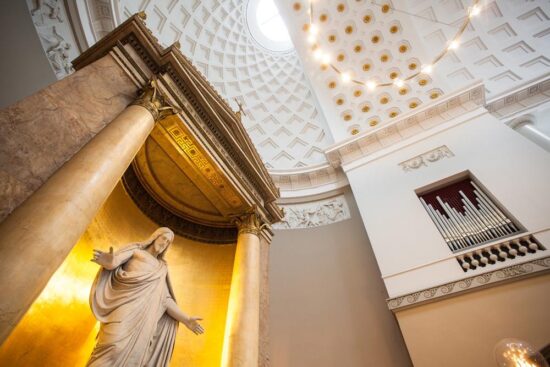Vor Frue Kirke
A few steps north of Gammeltorv (Nørregade street will take you to the Cathedral. The street starts from the north corner of the square) lies the city’s iconic cathedral, Vor Frue Kirke (Church of Our Lady). A church has stood here since 1209. The present building was consecrated in 1829, its predecessor having been destroyed in the Bombardment of Copenhagen in 1807. When Bishop Absalon decided to erect a royal castle in the fishing village of Havn, the small settlement was designated to fulfill a central role in the new kingdom of Denmark.
A small church had already been built in the village (the remains have been discovered under Strøget, close to the City Hall Square) but a larger church was required to match the rising prominence of the town. A document written by Absalon in 1185 and sealed in 1187, acknowledges the receipt of tithes for the construction of the building and the decoration of the Church of Holy Mary.
The Church of Holy Mary, built in limestone at the highest point of the town at the time, was not ready to be consecrated till 1209. The ceremony was conducted by Peder Sunesøn, Absalon’s successor, and took place, apparently, on Annunciation Day in March, a day that is still celebrated as the anniversary of the making of the church.
The new church was a collegiate and associated with Roskilde Cathedral, in effect almost on a par with it, and given a large staff of Dean, cannons (kanniker in Danish, as reflected in the names of nearby streets Store Kannikestræde and Lille Kannikestræde) and vicars.
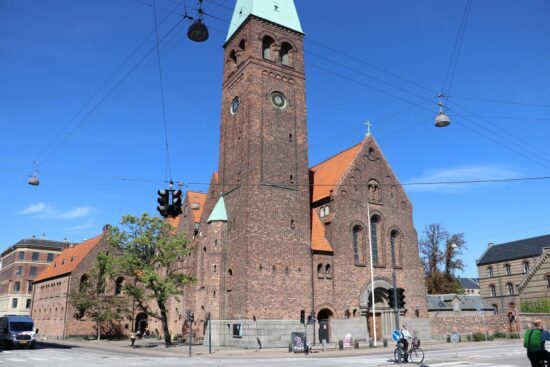
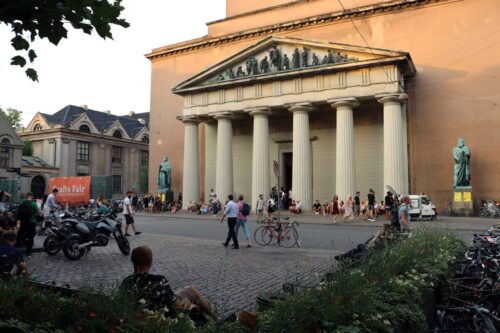
A school was attached to the cathedral which then became a center of learning. When the University of Copenhagen was founded in 1479, the Dean of the cathedral also served as the Chancellor of the University, the cannons conducted the teaching, and the Cathedral School provided room for the University in the early years.
Before this, the Cathedral had risen in importance in other ways, too. It was associated with the royal family when King Valdemar Atterdag gave away his nine-year-old daughter Margrethe – later Queen Margrethe I – in marriage to the Norwegian King Haakon in the church in 1363.
When King Christian I and Queen Dorothea were crowned and married in the church in 1449, it had risen to become the principal church of the realm. This increase in status, however, did not put an end to the damages inflicted on the church in war and repeated fires. In 1314 a fire had again ravaged the limestone church, this time so violently that it had to be entirely rebuilt, using more modern material: bricks.
At the time of the Reformation in Denmark, Vor Frue Kirke and its surroundings became the setting for much unrest. The prelates of the church attempted, for a long time, to keep the church as the principal bastion of Catholicism, and as a result, large groups of angry citizens forced their way into the building on the day after Boxing Day 1530 and vandalized much of the furniture. A year after the introduction of the Lutheran order in 1536, the change was celebrated in two large festive services in the church, presided over by Martin Luther’s associate Johan Bugenhagen.
In 1539 Bugenhagen returned to Vor Frue Kirke to consecrate the new Lutheran bishops of the realm. In 1568, a procedure was established in cases of uncertainties concerning the proper conduct of a Lutheran service. Services at Vor Frue Kirke in Copenhagen, from then on, defined accepted practice.
The Great Fire of 1728 affected five of the churches in Copenhagen, including Vor Frue Kirke which had to be rebuilt again. It was consecrated in 1738 but had a short life for a church. During the Napoleonic wars, the English attacked Copenhagen. For the first time in history, shells were shot at the civilian population from ships at the entrance to the port. They used the very tall spire on Vor Frue Kirke as their sighting point, and on the night of 5 September 1807, a rocket set fire to the spire which collapsed into the nave of the church and set the entire building on fire.
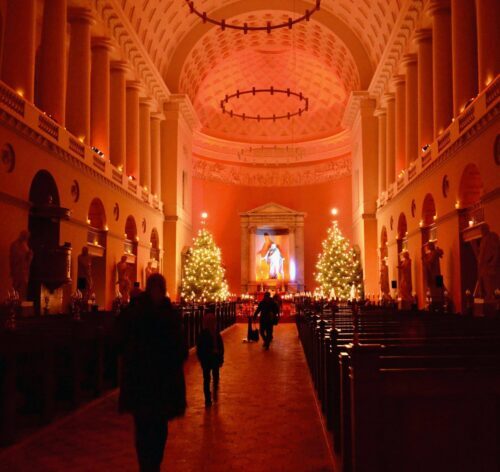
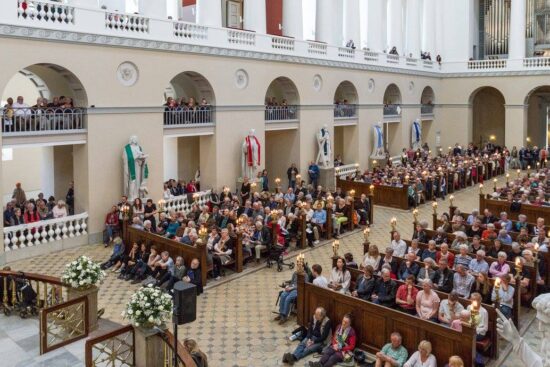
After her defeat in the Napoleonic wars, Denmark was deep in debt, so there was little money for building churches. All the same, discussions of various plans led to a decision to begin reconstruction of the principal church in the country with the principal architect in the country, C. F. Hansen from Holsten, at the helm. This also meant abandoning the idea to reconstruct the church in its traditional style.
The church would be built in the “modern” style that C. F. Hansen represented and which he had practiced in several remarkable buildings in Copenhagen, Greco-Roman neo-classicism. (Large sections of the old building could, though, be used in outer walls and the tower). Moreover, the sculptor Bertel Thorvaldsen was an obvious choice for the task of decorating the interior; he was even then of considerable international fame.
The foundation stone was laid by King Frederik VI in 1817, and on Whitsun Day 1829, the church was ready for its solemn consecration. The new remarkable church has framed a rich church life ever since, during the first decades – coinciding with the Golden Age – with Bishop I.P.Mynster as a highly respected preacher and C.F.Weyse, succeeded by I.P.E.Hartmann as organist, to name but a few. Søren Kierkegaard attended services here, especially Eucharist on Fridays, and despite his attacks on the church, his funeral service was held here, as was the case for Thorvaldsen and Hans Christian Andersen.
In 1924, the diocese of Zeeland was divided into two, and then Vor Frue Kirke was given the parallel name of Copenhagen Cathedral. Since the 1950s, the Boys’ Choir of Copenhagen has been associated with the church. Major renovation organized by Professor Vilhelm Wohlert in 1977-79 removed various additions that had accrued in the interior of the church over the years. A new large central organ was completed in 1995, with a choir organ added in 2002.
The building measures 83 m in length and 33 m in width. The interior of the nave is 60 m long and over 25 m from floor to ceiling. With all galleries open, the church can seat more than 1100 people. The tower is 60 m high and houses the four church bells (Stormklokken weighs 4 tons and is the largest bell in Denmark. The smallest bell in the tower, used at morning service among other occasions, is the oldest bell in the country, dating from 1490 and taken from Antvorskov Klosterkirke). Description / More

